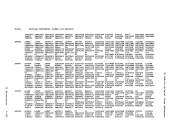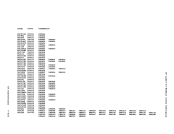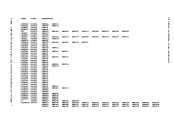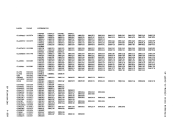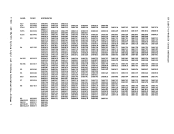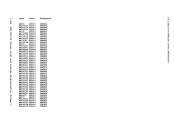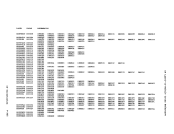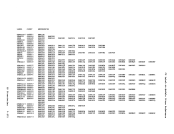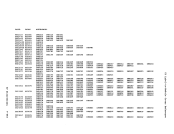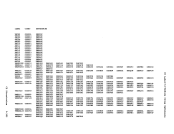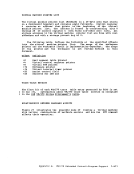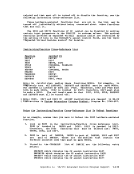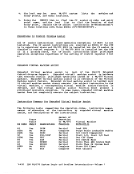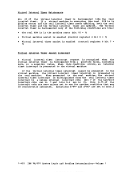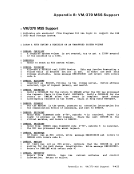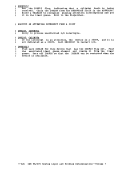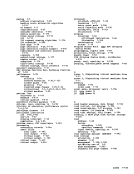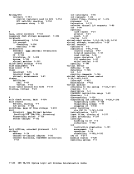1
40 6 0,1 DMKENTTI Data Items Collected Softvare--ana--hardware utilization, contention,
activity counters
Corresponding items forAPU VMBLOK user resource consumption and status DASD and tape activity counters
and
--Entered via TRQBLOK every two seconds (unless specified otherwise
with theMONITOR INTERVAL command). A new TRQBLOK is i.mediately
stacked via a call toDMKSCHST to specify return of control to the
same entry point two seconds later. This subroutine is a high
frequency (relative to thePERFORM, USER, DASTAP sa.pler) I/O status
sampler. All channels are tested for a busy condition with aTCH instruction. All control units and devices are tested for a busy
condition byexamining the appropriate CP control blocks. The data
obtained is accumulated for later sampling by theDASTAP class of
data collection in a class 6(DASTAP) code 2 (I/O status) record.
The subroutineDMKENT62 performs this collection after the standard
class 6(DASTAP) code 1 record has been collected by MONCOD61 in DMKMONTI. DMKMONMI --~ntered from DMKPRG after a monitor call in a class currently enabled
(as defined in CR 8 mask) has been executed byCP in supervisor
state. The .onitor call instruction number and code number stored by
the hardware in thePSA are used to index branch tables to reach the
appropriate data collection routines. As necessary, the data is
stored in the monitorI/O buffers before output. Upon completion, control returns to instruction after monitor call.
Class~gg§ ---1- 0 1
2
3
2 2
3
4
50 7 0 8 0 DMKMONPR lct~!~!I-Bei~~onitore~ Begin console read
Console output
End console read
Console sleepUser dropped from queue User added to queue User added to eligible list
privileged instruction beingsimulated SIO for DASD SEEK
Addqueue, drop queue more detailed
consuaption data
resource-~ll--data collection subroutines use a common buffer management subroutine to obtain sufficient space in the monitor buffers. When not enough space is available, a switch is made to the next buffer in
the chain and the full buffer is scheduled for output via aCPEXBLOK. I/O is handled by DMKIOSQR if tape is in use, or by DftKftIliO if a
spool file is in use. If data collection gets ahead of buffer output
and all themonitor buffers are filled, a temporary suspension
occurs.DMKMONIO -- Handles normal and abnormal completion of buffer output to disk or
tape. Fornormal completion, the buffer used for I/O is made available for further data collection; if the next buffer is already
full, its output is immediately scheduled. If a suspension was in
effect, data collection is immediatelyresumed using the freed
buffer.(RQte: Suspensions should be eliminated by increasing the
buffer allocation, using theMONITOR co.mand or the SYSMON macro.) Special tape conditions that can be handled include end of tape and
permanent error.
1-186IBM VM/370 System Logic and Problem Determin~tion--Volume 1
4
activity counters
Corresponding items for
and
--
with the
stacked via a call to
same entry point two seconds later. This subroutine is a high
frequency (relative to the
sampler. All channels are tested for a busy condition with a
condition by
obtained is accumulated for later sampling by the
data collection in a class 6
The subroutine
class 6
(as defined in CR 8 mask) has been executed by
state. The .onitor call instruction number and code number stored by
the hardware in the
appropriate data collection routines. As necessary, the data is
stored in the monitor
Class
2
3
2 2
3
4
5
Console output
End console read
Console sleep
privileged instruction being
Add
consuaption data
resource
the chain and the full buffer is scheduled for output via a
spool file is in use. If data collection gets ahead of buffer output
and all the
occurs.
tape. For
full, its output is immediately scheduled. If a suspension was in
effect, data collection is immediately
buffer.
buffer allocation, using the
permanent error.
1-186






















































































































































































































































































































